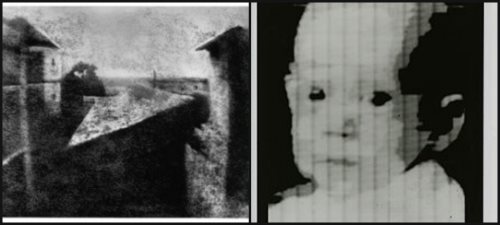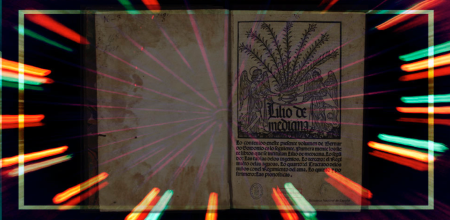Isabel Bordes Cabrera es Jefe de Área de Biblioteca Digital, Biblioteca Digital Hispánica a la Biblioteca Nacional de Españaña / Isabel Bordes Cabrera is Head of Area at the Hispanic Digital Library at the National Library of Spain
Because of the world digital preservation day (#WDPD2018) we’ve wanted to take a break so to think and explain what is digital preservation, what is not and why this need arrived to memory institutions.
In our personal lives we've all experienced ourselves losses of digital data: that CD or USB with pictures of our last summer that won’t ever open again, that computer that can’t read DVDs; that wordperfect file which we cannot longer open nor edit, that corrupted file that cannot be recovered, that videogame we can no longer enjoy because we no longer have that commodore 64 which delighted us on those rainy evenings…The challenges of digital preservation have knocked everyone’s door, and not even NASA is an exception. Furthermore, NASA was one of the first institutions to react when they realized that almost all data from Viking probes were lost. And this was true even when they thought they had solved the problem back in the 90’s when they transferred data from the original magnetic tapes to CDs. And why was that? Because formats were not readable and the original programmers were either dead or had already left NASA. These facts put the machine to move and digital preservation turned into an undeniable challenge to all of us.

To the left: appearance of a corrupted jpeg and to the right one of those fearful messages we can receive and let us see the tip of the iceberg (speaking of digital preservation challenges)
Digital preservation is not a synonym of digitization; furthermore, digitization or just owning digital born collections create a need for setting up and implementing policies, plans, measures and digital preservation tools. These measures, in short, aim at ensuring the reuse and access to those materials throughout the time, because that is precisely the objective of this discipline. The challenges and solutions to implement are so numerous that more and more libraries (especially outside Spain) have bet it all setting up human specialized teams, with mixed profiles between traditional librarians and IT engineers, all focused in answering the issues we come across regarding digital preservation.
But let’s spend some time in reflection and travel to the recent past, and even to a not so close one. We could say that Human history swings between two states which alternate in a cyclical manner: the admiration for reality and the obsession to fix it or at least capture it for the future. This is true for any field we could think of: word, image, music, Chemistry, Genetics, Biology…As for the image, since Nièpce succeeded fixing the first photographic image, numerous patents followed each other in order to improve the copy of images, to obtain steadier photosensitive emulsions and lighter equipment and materials, to be able to print photography (initiated by photolithography). As time went by, not only this, but photography arrived within everyone grasp thanks to giants such as Kodak. Skipping “a few decades”, we reach 1957, a year in which obsession for the capture and fixation of images arrived to computer's world, when Russell Kirsch and his team obtained the first digital image thanks to the first scanner (SEAC): a picture of his three-month-old son Walden. This, of course, was only the early beginning of digitization.

To the left, the first fixation of a photograph (Point de vue de la fenêtre du Gras, 1826 by Nièpce). To the right, first digital image obtained by the scanner designed by Russel Kirsch and his team in 1957: a picture of his son Walden.
By the end of the 90’s and early 2000’s, digitization knocked on the doors of libraries and memory institutions. With more or less ambitious projects, more or less resources and luck, the massive conversion to 0 and 1, mainly, of our paper collections began. This very conversion implied a promise of potentiality, ubiquity and permanence which, in more than one or two cases, led to a naïve euphoria. The digital dimension opens us up to an endless world of possibilities. The libraries, museums, archives were able to be omnipresent and ubiquitous “by the magic byte”. However, as stated ahead, more than once this euphoria could have been a bit out of focus, affecting directly our current conception of digital preservation
But facing the optimism of change there is always certain opposition. Maybe just as an example of resistance to change, so common in the human being, but also as an example of the fear of losing what we already had, and has proved to live thousand years: the paper book. In Spain there is a well-known vignettist (El Roto) who has devoted few questioning vignettes to digitization and ebooks? In one of them a pile of books says to another one: “before we were burnt, now we're digitized”, and the other one answer “is not the same”, receiving as a laconic answer: “we shall see”.
In spite of this duality, our institutions were and are certain: we had to bet it all to digital (not only to digitization), to the opening of knowledge, to the creation of digital, virtual libraries... and, of course, to the reuse of digital contents
And why do I speak about an initial lack of focus? Because, all of a sudden, digitization seemed to be the manna, the panacea that cured everything (we no longer needed to serve the damaged document at the reading rooms, we would avoid the issue of physical space in our deposits), that could do anything (replacing the original, preserving the original forever) and it would be a process not to be repeated (as if we hadn’t photographed or microfilmed few times before…). Not to mention the endless possibilities of born digital collections that would arrive to our collection in the mid 2000’s (via web archiving, electronic legal deposit, record management…).
With digital collections begins our dialogue with software providers in order to build up digital libraries; the definition of specifications and digitization formats doomed to be constantly updated; the election of storage media and carriers subject to planned technological obsolesce; the risk of losing files by spontaneous corruption; the incompatibility of certain software with a particular hardware; the viruses that either delete or encrypt files; deletion (intentional or not) of files… In a nutshell, we “are starting” to learn that our digital collections didn’t come to save us from the risks of paper, but they entail their own risks (in spite of their undeniable advantages). In fact, as a graphic example, in digital world the traditional space issue that libraries have had in their physical stores has not disappeared, it has only been transformed into issues of storage space in our servers. We might not talk about Km of bookshelves, but in turn we’ve initiated and endless race of tenth power figures (byte, megabyte, gigabyte, terabyte, petabyte…) and who knows if there is a limit at the other side of the road.
The truth is that either by web archiving, e-legal deposit, e-record management, or digitization, we are creating a “new form” of heritage which we are obliged to preserve. Those “digital incunabula” need a PROACTIVE approach, different from preventive conservation measures used for paper incunabula. Steady levels of humidity and temperature and minimizing the copy handling are no longer sufficient strategies. Furthermore, if those were the only measures to be taken we would head toward a loss of our digital collections. Those “digital incunabula” need an active intervention all through their life cycle in order to minimize the risks they face, so to ensure they remain readable and reusable not only today, but also in the future. All these actions we need to take aiming readability and reuse potentiality is what we know as digital preservation. A management which seeks minimizing risks, may be not eliminating them, but preparing ourselves to react to a particular issue. Why? Simply because there is no digital collection (born digital or not) which has survived more than 30-40 years and, for sure, we don’t know beforehand all the challenges that might come across our path.

Digital collections are a “new form” of heritage to be preserved, “digital incunabula” almost as valuable as those coming from the manual printing press
The initial-and-brief-out-of-focus euphoria in which certain digital projects might have had at their beginning, obliges today to repeat to ourselves and our managers, at least, three mantras:
- Digitizing is NOT preserving
- Storing IS NOT preserving EITHER (although all digital preservation system must function over storage facilities and maintain at least two copies geographically distant from each other)
- The investment in digital preservation is an investment in perpetuity. From the very moment an institution neglects this aspect regarding its digital collections, is taking a risk of losing its digital libraries and the investments of the last decades in digitization, web archiving…

Three basic mantras to convince our managers, and ourselves, that digital preservation is here and has come to stay
At BNE the setting up and implementation of digital preservation policies and plans is a reality and there have been important advances. Being a responsibility of the Digital Library Area, in tight knit with IT Coordination Unit, it has to be taken into account, as previously mentioned, that is has to be managed altogether by IT and librarian profiles. Anyway, for sure, it is a mission in which all BNE departments has its implication and degree of responsibility.
Since 2012 the BNE has a digital preservation system. This system is based on the product Libsafe developed by the Spanish company Libnova. This product was born altogether with the massive digitization project that led to the creation of Biblioteca Digital Hispánica (BDH or the digital library of the National Library of Spain) and in very few years, has turned itself into a leader in the international market. In fact, several international institutions have bet on it: Digital Preservation Network, British Library. This system allows, amongst other things, to check integrity and authenticity of its digital collections, launch audits, protect them from accidental losses, manage format migration when needed because of obsolescence…etc. Of course, its implementation is not complete and many fronts of advance are still to be faced. Anyway, first steps have been taken forward, in such a complex world like this, there are no perfect solutions, not everything is clear, but is better to get started and not aiming the perfect answer. If that was the case we might be paralyzed.
In the meantime, please keep an eye on your screens, because shortly BNE will publish its digital preservation policy, a statement of our philosophy and objectives that will be regularly updated and will mainly seek the formalization of our principles and the roadmap that will guide our following steps. Because in the digital world, existing is not enough, we also need to tell that we actually do. As Apelles the Greek painter said: “Nulla dies sine linea” (not a day without a line referring to the need of an artist to never stop drawing), and I would add: “Nulla dies sine linea…digital”.
Isabel Bordes Cabrera, Jefe de Área de Biblioteca Digital
Biblioteca Digital Hispánica: www.bdh.bne.es
CREDITS FOR THE IMAGES
First digital image in history: https://en.wikipedia.org/wiki/Russell_A._Kirsch#/media/File:NBSFirstScanImage.jpg
Secula seculorum. https://www.flickr.com/photos/olivierh/36320991961 (Olivier H)
